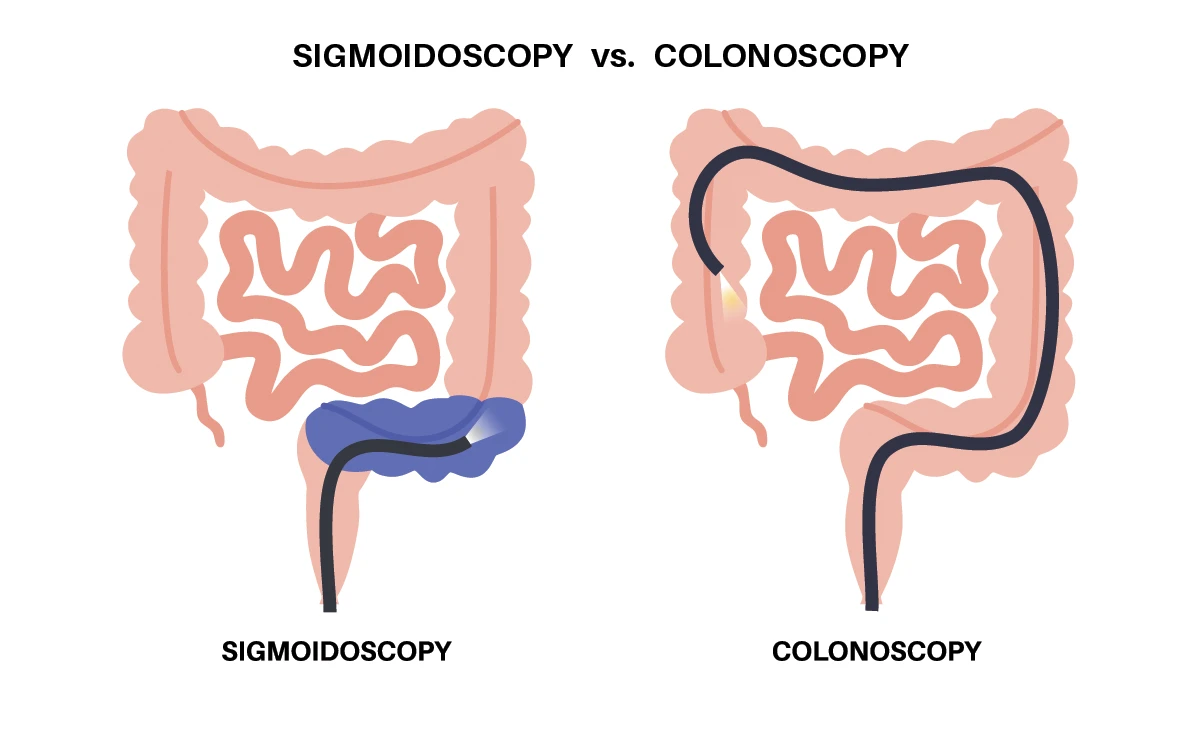Flexible sigmoidoscopy
A flexible sigmoidoscopy is a diagnostic test that checks the lower part of your colon known as the sigmoid colon. This test can be used for colorectal screening for cancer and can diagnose a variety of gastrointestinal disorders. It’s an alternative to a colonoscopy and other gastrointestinal imaging tests.
What to expect during a flexible sigmoidoscopy
During a flexible sigmoidoscopy procedure, you’ll be placed on your side with your knees drawn toward your stomach. Unlike a colonoscopy, you won’t be sedated while having a flexible sigmoidoscopy.
Your doctor will insert a tube with a camera attached, known as a sigmoidoscope, into your rectum. The sigmoidoscope also contains a light and a tube that allows air to be put into the colon to expand it. The camera sends images to a monitor so your doctor can get a view of the inside of your colon.
The procedure takes around 15 to 20 minutes but could take longer if a biopsy of the tissue is taken. If a polyp is found, your doctor may recommend a colonoscopy.
After the procedure, you may feel mild discomfort, along with feeling bloated or the need to pass gas. Walking may help relieve some discomfort.
Flexible sigmoidoscopy vs. colonoscopy

A flexible sigmoidoscopy and a colonoscopy are valuable tools to screen for and diagnose GI disorders. Both use a tube with a camera to look at the colon. However, a flexible sigmoidoscopy only looks at the sigmoid colon, located in the lower part of the large intestine. A colonoscopy tube is longer and is used to look at the whole large intestine (colon).
A flexible sigmoidoscopy is a less invasive procedure than a colonoscopy and the screening is done every five years, whereas a colonoscopy is recommended every 10 years.
A colonoscopy is the primary colorectal screening test used to check for colon cancer, while a sigmoidoscopy is commonly used to check for causes of rectal bleeding, diarrhea and abdominal pain.
Flexible sigmoidoscopy advantages & disadvantages
Colorectal screening is vital for early detection of colon cancer. Aside from the benefit of being less invasive, a flexible sigmoidoscopy can detect the formation of polyps before they turn into cancer.
Advantages of a flexible sigmoidoscopy
- It can accurately find polyps in the lower colon.
- Typically, the procedure does not require sedation.
- It takes less time to complete the procedure.
- Many primary care providers can do this test in their office.
Disadvantages of a flexible sigmoidoscopy
- Not all polyps can be removed, but your doctor can do a biopsy.
- The test may be uncomfortable to some people.
- There’s a slight risk of bleeding.
- It only checks part of the colon.
- Preparation requires an enema or laxatives.
Preparing for your flexible sigmoidoscopy examination
Your doctor will discuss with you how to prepare for your flexible sigmoidoscopy test. You’ll need to completely empty your colon prior to testing.
Common preparation measures include:
- Following a liquid diet 24 hours prior to the test
- Removing dairy products the day prior to testing
- The use of laxatives or an enema the night before the exam
- Adjusting or stopping medications, such as iron supplements, aspirin or other blood thinners before the test. Your doctor will give you guidance on how to adjust or when to stop taking medications prior to your flexible sigmoidoscopy.
Recovering from a flexible sigmoidoscopy
Unless your doctor says otherwise, you can resume your normal diet and activities after the procedure. You may have a little discomfort and pass gas more frequently than normal. If a biopsy was performed, you may experience some bleeding. If bleeding lasts more than a day or you have fever or chills, contact your doctor.
Are you at risk for colon cancer?
Colon cancer is the third most common cancer among men and women in the U.S. Our colorectal health quiz determines your estimated lifetime risk for colon cancer and gives you an idea of what to do next based on your results.
Get care
We help you live well. And we’re here for you in person and online.
